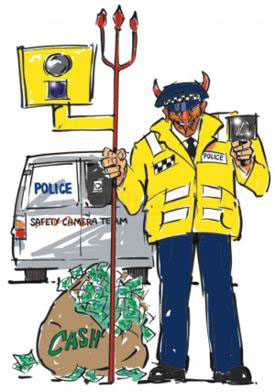 There is a popular expression that states, “There is nothing new under the sun,” and that is certainly true for toll roads; they have been around for nearly 3,000 years. Companies or individuals would build roads and then patrol them, collecting tolls to allow foot traffic, those on horseback, or those in wagons to continue to use them. This endeavor expanded to include toll gates as areas were built up into cities, market places, or other areas where people needed to travel. Here in the United States the first official toll road was the Philadelphia and Lancaster Turnpike which was built in Pennsylvania in the 1790s, but Florida’s first, the Florida Turnpike, wasn’t opened until the mid- to late 1950s.
There is a popular expression that states, “There is nothing new under the sun,” and that is certainly true for toll roads; they have been around for nearly 3,000 years. Companies or individuals would build roads and then patrol them, collecting tolls to allow foot traffic, those on horseback, or those in wagons to continue to use them. This endeavor expanded to include toll gates as areas were built up into cities, market places, or other areas where people needed to travel. Here in the United States the first official toll road was the Philadelphia and Lancaster Turnpike which was built in Pennsylvania in the 1790s, but Florida’s first, the Florida Turnpike, wasn’t opened until the mid- to late 1950s.
Today, in keeping with the ancient idea of toll roads, there are now also toll bridges and toll tunnels. These are no longer private enterprises, but are run by state or local governments and used exclusively for automobiles. The funds that are garnered at these toll locations are used to either maintain the roads that are there already or to help fund new projects. Lately, it seems that these projects are arising with ever-increasing frequency along the East Coast, which is especially true here in Florida. Ironically, the concept of increasing toll roads in South Florida was originated from Southern California in the 1980s. The planned increase of toll roads in South Florida can be credited almost exclusively to a single person. Bob Poole is an MIT engineering graduate, founder of the think tank Reason Foundation, and a former Los Angeles resident. Poole drafted a proposal in 1988 to designate one or two lanes of traffic that allowed drivers to pay a toll and travel more quickly. Sounds like a great idea when you consider the purpose of modern-day toll roads is to help move motorists from one point to another in the most efficient way possible. Once implemented in California, the idea became an instant success.
“People were suddenly able to go the speed limit on one of the most congested highways in the country,” Poole said. For the most part, this is a great idea; however, think about the massive influx of people into the state in the last 60 plus years. When you consider that this system of toll roads became widespread initially in an effort to more easily connect people in remote areas at a time when we didn’t have the population we have now, it is easy to understand how bogged down toll roads can get these days. For a system that is designed to provide smooth, expedited travel, one accident or slow driver can gum up the whole works. This, however, is a minor snafu in the grand scheme of things and has not dissuaded the State of Florida from advanced planning of several more toll roads here. Currently, there are plans underway to add 169 miles of toll lanes to some of the state’s largest cities. These projects are expected to last until at least 2021 and will be predominantly affecting Tampa, Orlando, Jacksonville, and of course, South Florida.
There is also the cost to consider; both the cost of construction and the cost of the toll. For many motorists who commute daily, toll roads can be a godsend, but the cost of tolls can vary widely. Many tolls are standard rates with a variance dependent upon the number of axles a vehicle has. Other tolls vary depending upon how much traffic is using the express lane at any given time. A toll can be as little as 50 cents or go up to as much as $10.50 depending on how much traffic is using it at the time – the greater the volume of traffic, the greater the cost of the toll. This seems acceptable to many drivers who would pay nearly whatever the cost to avoid the grind of trying to navigate through the immense traffic on South Florida roadways.
The upcoming toll lane projects are the result of state-funded reports produced by the Reason Foundation and are partially funded by toll lane developers. A slight shadow of impropriety overhangs these projects as Ananth Prasad, the Secretary of the Florida Department of Transportation, will be supervising these projects. Prasad formerly worked for one of the state’s biggest toll lane builders which will receive billions of dollars from the toll lane projects which Prasad approved. Once these projects are completed, they will result in the biggest infrastructure project in the history of the state. The cost of these projects seems to be a source of some debate, and it is difficult to get a handle on what the ultimate cost of this infrastructure construction will be. Many of the toll lanes will be funded through the use of bonds so over the course of the time that it will take to pay off those bonds, a $2 million project can easily become a $10 million bill.
Here are some of the upcoming toll road projects, along with their estimated costs and pending completion dates:
I-95 Express Lanes Phase 2
Cost: $112 million
Length: 14 miles
Scheduled to open: April 2015
Palmetto Express
Cost: $244 million
Length: 13 miles, from West Flagler Street to Northwest 154th Street in Miami
Scheduled to open: 2017
Homestead Extension of Florida’s Turnpike
Cost: $186 million
Length: 18 miles, from Tallahassee Road to State Road 836
Scheduled to open: First phase, 2017; second phase, 2018
I-95 Express Lanes Phase 3
Cost: $901.6 million (estimate)
Length: 29 miles
Scheduled to open: A portion will open in 2019; the rest is to be determined
I-75 Express Lanes
Cost: $481 million
Length: 15 miles
Scheduled to open: 2019
As with any major construction project, the dates of completion as well as the cost to build them are arbitrary. There are always unforeseen costs and delays associated with projects on the scale of these. Of course, there are many drivers who don’t use local toll roads extensively and may be surprised to learn not only of the varying costs associated with the individual toll roads, but also the varying methods of payment expected. Often when a toll road novice approaches a toll booth, they will start digging around the car looking for change, only to be caught in an awkward position when they realize that some toll roads don’t accept cash. Other toll roads use a transponder system such as the SunPass, or a toll-by-plate method, and others may use a combination of these methods of collection. The toll-by-plate program can often be more expensive because of the administrative costs involved.
The important thing to remember is that not paying a toll, regardless of the method, can result in a stringent fine and additional fines being incurred if not paid in a timely manner. This is true even if you are unaware of the infraction. As with other types of traffic tickets, sometimes court costs, points on your license, and a possible driver’s license suspension may occur. Consequently, if you find yourself with an unpaid toll ticket, give us a call at 964-967-9888 for a free consultation. Hiring a traffic ticket attorney can help protect your driving record.

FREE CONSULTATION
866-433-3363
Call now or contact us for a fast, free, no obligation consultation.

